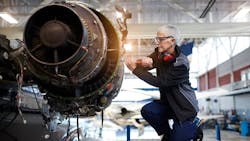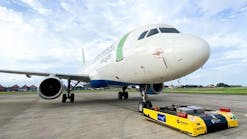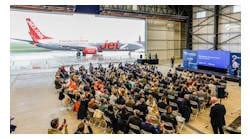Heavy checks are hard. Put a transport category airplane in a hangar. Disassemble it into its simple parts. Inspect it. Repair what you find. Reassemble the whole mess in a way that makes everything work again. Deliver it on time at a predicted date and within a budget. That’s hard.
It’s no wonder so many airlines do not invest in the skills and material requirements that are required to make just one check delivery a success, let alone a heavy check line. Taking on heavy checks is essentially operating a separate company within the air carrier.
Why Outsource?
Traditionally, airlines had large maintenance organizations installed in large hangars that were small cities made up of technicians and specialists doing everything from interior touch up to Large D check airframe overhauls. Some carriers still do. American Airlines' maintenance facility in Tulsa, OK is a fine example.
Other reasons that airlines outsourced include:
- If an airline maintains its own fleet, they may outsource maintenance requirements in excess of their baseline capacity. Air Carriers having their own hangar resources for heavy checks have the challenges of maintaining their check lines so that peaks and valleys in aircraft utilization don’t drive similar peaks and valleys in resource needs.
- New aircraft may require outsource maintenance for specific aircraft type until internal resources are developed for bringing work in-house.
- Air carriers contract out for specific maintenance functions such as engine repair, overhaul or system component repair.
These reasons are still relevant to today’s use of outside maintenance providers.
After deregulation in the 80’s, folks began to think about reducing costs. Start ups, and regionals especially, had very narrow margins of profitability. With maintenance costs taking up to 40 percent of an air carrier's cost structure, outsourcing became an attractive option. An operator could reduce cost by transferring traditional overhead to maintenance providers. This allowed air carriers to focus on value-added efforts, supporting fleet growth and passenger loads. In addition, the proliferation of smaller budget carriers made outsourcing a strategy that contributed to their profitability.
The current trend of outsourcing has evolved. The MRO industry has grown to accommodate the capacity and technical demands that outsourcing created. In recent years, MRO surplus capacity has decreased. Concurrently, labor rates demanded by MROs have increased to a level that encourages investment in facilities and equipment. Original Equipment Manufacturers (OEMs) have decided that MRO is an important source of income, post aircraft sale. Having particular aircraft knowledge, skilled work forces and access to efficient supply chains, they have a leg up on enticing air carriers to contract with them as they acquire MRO capabilities.
Mitigation and Controls
Air carriers and the FAA have invested heavily in the procedural infrastructure that promotes safer operations using out sourced maintenance — whether foreign or domestic. The following reasons contribute to maintenance provider performance.
Regulation
FAA regulations have been enhanced specifically to address outsourcing at all levels — 14 CFR Part 121.368 was designed to address maintenance provider oversight by the air carriers. It describes and directs robust oversight used to assure that contractors do all work in accordance with the air carrier's continuous airworthiness maintenance program (CAMP). While many lament a lack of FAA oversight for maintenance providers, the reality is oversight is maintained by air carrier programs that manage maintenance providers. As it always has — operators have real clout when it comes to addressing performance deviations by maintenance providers. The FAA is good at approving and addressing repair station issues tied to Part 145, but the quality of the maintenance provider’s output has always been in the control of the operator contracting the work.
Continuous Analysis and Surveillance System (CASS) (ref 14CFR Part 121.373)
Each air carrier maintains a program to assess the effectiveness of its program to include aircraft reliability and maintenance provider performance. CASS programs actually approve a maintenance provider for use by the air carrier. They accomplish audits and negotiate service level agreements that identify all the required standards expected in support of the work to be performed. Pre- and post-check assessments to include any quality escapes are investigated for root cause and corrected. The FAA oversees the effectiveness of these programs and, based on monthly reports required by Part 121.368, has a picture of the carrier’s performance in this area.
These programs alone employ hundreds of people whose main function is to approve use of maintenance providers, do continued surveillance, report deviations and assure corrective action. It makes no difference whether the maintenance is domestic or foreign.
Safety Management Systems (SMS)
SMS has now been incorporated into the air carrier’s tool kit where hazard identification supporting aircraft safety is a key part of safety oversight. Hazards most under scrutiny by safety and quality surveillance include:
- Management and accomplishment of required inspections (an inspection of specific items the operator determined to be flight critical)
- Compliance to task requirements of the aircraft inspection program
- Incidents and deviations related to quality and safety escapes
Contractor Standards
All Part 121 air carriers have maintenance provider standards. Whether foreign or domestic, the same provisions apply. Maintenance providers have to provide the following:
Adequate personnel – Quantitative and qualitative considerations are in play — there has to be enough personnel having the adequate skills. Quality organizations assess level of experience in comparison to the fleet type and maintenance schedule requirements of the carrier. Adequacy of organization is assessed. Supervision and inspection resources used by the provider are evaluated against the context of the work that is anticipated.
Adequate facility – Hangar facilities' size and organization is important. A large MRO houses many aircraft of many types. Are they protected from fire or other hazards? Do personnel have adequate protections from environmental hazards? How well is it maintained? Is it efficient and provide adequate lighting and access?
Availability of tooling – Adequate tooling must be demonstrated. How the tools are used and maintained is assessed. All repair stations must have proper tooling required by the manufacture in place when the work is performed.
Training skills – Personnel training is required and demonstrated. Operators must assess the experience and competency of MRO personnel. Training is required for certificated and non certificated personnel alike.
The same criteria are applied to in house maintenance operation for operators. The standards and expectations of performance are the same.
Outsourcing Challenges
Capacity and infrastructure – Some MROs still suffer from operations geared for the repair of older aircraft and have been slow to invest in technologies that would support maintenance on new generation airframes. In recent years, MROs have made investments in training and equipment to service new generation aircraft. Infrastructure with improved IT platforms are becoming available that include the use of big data, predictive maintenance and AI. With MRO heavy check capacity becoming saturated, the MRO industry is starting to assess the risk of investment in new check facilities through acquisition or construction. The MRO industry is expected to grow 3.5 percent per year through 2029. With hangar space filling up fast, air carriers are now making hangar slot reservations years in advance to assure availability of space sufficient to support their fleet maintenance schedules.
Personnel –Based on surveillance standards used and performance metrics by air carriers, training and competency of foreign repair station personnel are equivalent to the A&P mechanics as a matter of practical application. Further, MROs have the same challenges as air carriers when it comes to acquiring trained and experienced personnel. How well they can continue to compete for the necessary skills and talent remains to be seen. Concerns regarding supervisory ratios of supervision are warranted, but not as important as the resources and competency the maintenance provider has invested in the work force in general.
Technician Shortages
The simple math is that seasoned experience levels are being spread thin. MROs and Air Carriers are suffering from diminishing technical skill as experienced mechanics leave the workforce. MROs especially are losing experienced mechanics as air carriers draw them in to support their own operations. For both, necessary labor needed to maintain aircraft will be covered by overtime and where necessary, contract labor.
For MRO, non certificated technicians are leveraged into the labor pool as well since they are allowed under repair station rules. Foreign and domestic MROs alike will be depending on non certificated personnel. Domestic MROs would benefit from encouraging those people to acquire the necessary experience to qualify for an A&P license. While there is general consensus that a technician shortage exists and is expected to worsen — there is no unified effort that will address the shortage which Oliver Wyman predicts will be acute by 2029.
Outsourcing will Continue to be the Norm
Air Carriers are still focused on the three things they have traditionally focused on: cost, on time delivery and aircraft quality. All of which they have the tools and responsibility to manage. Outsourcing will continue to play a major role in air carrier operations in the future, so long as they are able to deliver cost effective performance that competes with in house maintenance operations.
Drawing on 40 years of management in the aircraft maintenance and flight safety fields, Vern periodically writes about his experiences in aviation while working full time at stalking large trout and tinkering with wooden boats.





